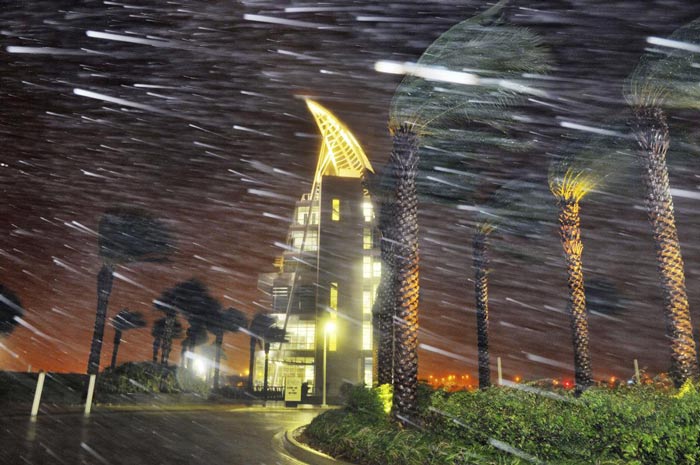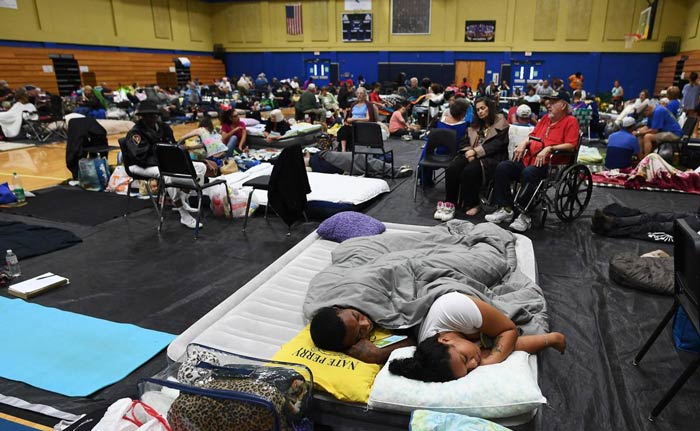DUNIA MAG | Twitter: @duniamagazine

Trees sway from heavy rain and wind from Hurricane Matthew in front of Exploration Tower early Friday, Oct. 7 in Cape Canaveral, Fla. Matthew weakened slightly to a Category 3 storm with maximum sustained winds near 120 mph, but the U.S. National Hurricane Center says it’s expected to remain a powerful hurricane as it moves closer to the coast. (Craig Rubadoux/Florida Today via AP)
BY MIKE SCHNEIDER and KELLI KENNEDY 
Hurricane Matthew sideswiped Florida’s Atlantic coast Friday, toppling trees onto homes and knocking out power to more than 800,000 people but sparing the most heavily populated stretch of shoreline the catastrophic blow many had feared.
Authorities warned that the danger was far from over, with hundreds of miles of coastline in Florida, Georgia and South Carolina still under threat of torrential rain and deadly storm surge as the most powerful hurricane to menace the Atlantic Seaboard in over a decade pushed north.
They warned, too, that the storm could easily take a turn inland.
‘‘It still has time to do a direct hit,’’ Gov. Rick Scott said in the morning. ‘‘This is not over. … It could be the worst part of this is yet to come.’’
Meanwhile, the magnitude of the devastation inflicted by Matthew as it roared through the Caribbean became ever clearer, with officials in Haiti raising the death toll there to nearly 300, while also cautioning that there were scores of bodies that had yet to be recorded.
In Florida, Matthew was downgraded to a Category 3 hurricane overnight, and its storm center, or eye, hung just offshore Friday morning as it moved up the coastline, sparing communities the full force of its 120 mph winds.
Still, it got close enough to knock down trees and power lines, damage buildings and flood streets. Melbourne was hit by wind gusts of up to 107 mph.
In historic St. Augustine, Florida, the downtown district was impassable by noon because of a combination of seawater and rainwater. A giant oak limb had fallen in an old cemetery, and the power started going out in some neighborhoods as transformers exploded.
On Georgia’s Tybee Island, where most of the 3,000 residents were evacuated, Jeff Dickey had been holding out hope that the storm might shift and spare his home. As the rain picked up, he decided staying wasn’t worth the risk.
‘‘We kind of tried to wait to see if it will tilt more to the east,’’ Dickey said. ‘‘But it’s go time.’’
In areas the storm had already passed, residents and officials began to assess the damage.
Robert Tyler had feared the storm surge would flood his street two blocks from the Cape Canaveral beach. Tree branches fell, he could hear transformers exploding overnight, and the windows seemed as if they were about to blow in, despite the plywood over them.
But in the morning, there wasn’t much water, his home didn’t appear to have damage on first inspection, and his vehicles were unharmed.
‘‘Overnight, it was scary as heck,’’ Tyler said. ‘‘That description of a freight train is pretty accurate.’’
As the storm closed in over the past few days, an estimated 2 million people across the Southeast were warned to clear out.

Local residents take shelter at the Pedro Menendez high school in St. Augustine, Florida, on Oct. 6, ahead of hurricane Matthew. (Jewel Samad/AFP/Getty Images)
In the end, Matthew largely skirted the Miami-Fort Lauderdale-Palm Beach area of over 6 million people and hugged closer to the coast farther north, menacing such cities as Vero Beach, Daytona Beach, Cape Canaveral, St. Augustine and Jacksonville. Farther north, it threatened such historic cities as Savannah, Georgia, and Charleston, South Carolina.
At 2 p.m. EDT, Matthew was centered about 40 miles southeast of St. Augustine and 60 miles southeast of Jacksonville. Its winds had dropped to 115 mph, and it was moving northwest at 12 mph.
About 500,000 people were told to evacuate the Jacksonville area, and another half-million were under orders to clear out in Georgia.
Forecasters said 15 inches of rain and a storm surge of up to 9 feet were possible in places.
National Hurricane Center Director Rick Knabb reminded people in the danger zone that storm surge is the biggest threat to life during a hurricane, even when the eye remains offshore.
‘‘If you’re hoping it’s is just going to pass far enough offshore that this isn’t a problem anymore — that is a very, very big mistake that you could make that could cost you your life,’’ he said.
Airlines canceled at least 4,500 flights Wednesday through Saturday, including many in and out of Orlando, where all three of the resort city’s world-famous theme parks — Walt Disney World, Universal Studios and SeaWorld — closed because of the storm.
Airports in South Florida began returning to normal, however, with American Airlines seeing its first arrival at its Miami hub at 9:05 a.m.
Despite the warnings to leave, many hunkered down Thursday night and hoped for the best.
The door to Darrell Etheridge’s garage was blown off, but the Vero Beach resident said the storm was no big deal. There was no flooding and he had power for most of the night, only losing cable TV.
While the wind’s howling ‘‘sounded like a pack of wolves,’’ he said, ‘‘I got off damn good.’’
Sheriff’s spokesman Gary Davidson said at least four callers reported trees falling onto their homes in the Daytona Beach area. No injuries were reported.
Some people who refused to evacuate were stranded and called for help but were told to stay put until conditions improved enough for paramedics and firefighters to get to them, said emergency operations spokesman David Waters in Brevard County, the home of Cape Canaveral.
‘‘A family called in that the roof just flew off their home on Merritt Island,’’ Waters said.
NASA reported mostly minor damage at the Kennedy Space Center in Cape Canaveral, including damage to some parked cars and an office building roof.
Associated Press reporters Holbrook Mohr in Orlando, Florida; Gary Fineout in Tallahassee, Florida; Kelli Kennedy and Terry Spencer in Fort Lauderdale, Florida; Jennifer Kay, Freida Frisaro and Curt Anderson in Miami; Marcia Dunn in Cape Canaveral, Florida; Janelle Cogan in Orlando, Florida; Russ Bynum in Savannah, Georgia; Martha Waggoner in Raleigh, North Carolina; Jeffrey Collins on Hilton Head Island, South Carolina; Jack Jones and Meg Kinnard in Columbia, South Carolina; and Bruce Smith in Charleston, South Carolina, contributed to this report.
Join mailing list for updates and monthly newsletters
